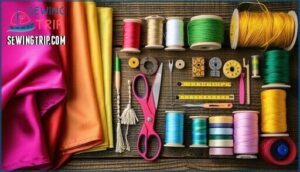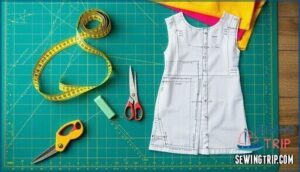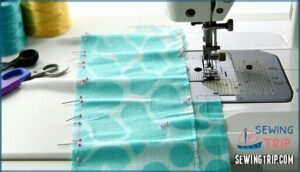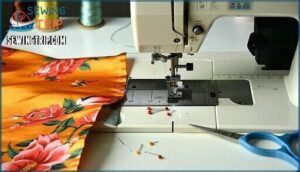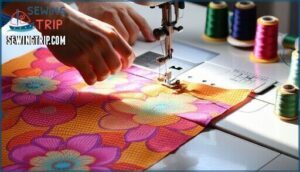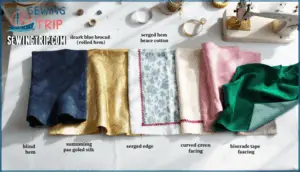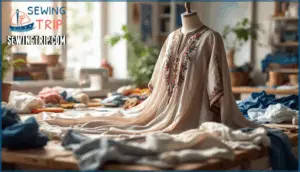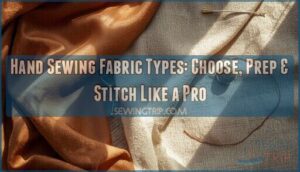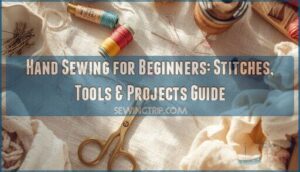This site is supported by our readers. We may earn a commission, at no cost to you, if you purchase through links.
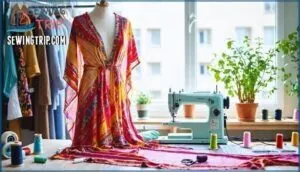
The secret lies in understanding how a few straight seams and strategic fabric choices create that relaxed drape that’s made kaftans a wardrobe staple across centuries and continents.
Whether you’re drawn to lightweight cotton for summer resort wear or rich velvet for evening elegance, you’ll discover that sewing a kaftan rewards you with maximum style from minimal construction.
Table Of Contents
- Key Takeaways
- What is a Kaftan and Its Origins?
- Which Kaftan Style Should You Choose?
- What Fabrics and Notions Are Best for Kaftans?
- How to Take Measurements and Prepare Fabric
- How to Sew a Kaftan Step by Step
- How to Add Finishing Touches to Your Kaftan
- How to Care for and Style Your Kaftan
- Frequently Asked Questions (FAQs)
- Conclusion
Key Takeaways
- The right fabric choice and a few essential seams make sewing a kaftan approachable, even for beginners.
- Kaftans have a long, cross-cultural history, with design details and cultural meanings that shift by region and tradition.
- Your selection of style, fabric, and construction method should match the occasion, draw from cultural inspirations, and fit your comfort needs.
- Accurate measurements, careful fabric prep, and thoughtful finishing steps are key to a well-fitting, polished kaftan that lasts.
What is a Kaftan and Its Origins?
Before you start cutting fabric, it helps to understand what makes a kaftan special and where this timeless garment came from. The kaftan’s journey spans thousands of years and multiple continents, shaping the loose, flowing silhouette you’re about to create.
The kaftan is a timeless, globe-spanning garment whose history shapes its iconic, flowing silhouette
Here’s a look at the key moments in kaftan history.
Ancient Mesopotamian and Egyptian Roots
Long before the kaftan became a runway staple or beach cover-up, it began its journey around 600 BCE in ancient Mesopotamia, where loose, flowing robes weren’t just practical—they were a statement of power worn by the elite of Egypt and Persia. These early kaftans established a cultural blueprint that still influences modern design:
- Ancient royalty in Egypt draped themselves in flowing garments made from fine Egyptian fabrics, signaling their elevated status above commoners.
- Mesopotamian textiles featured intricate weaving techniques that transformed simple robes into elaborate status symbols reserved for the wealthy.
- Cultural significance of kaftans emerged as these garments became synonymous with authority, setting the kaftan timeline in motion across civilizations.
Kaftans in The Ottoman Empire and Persia
As these ancient garments traveled from Mesopotamia through thriving trade routes, the Ottoman Empire and Persia transformed the kaftan into something far more opulent—a canvas for silk brocade, jeweled embroidery, and elaborate tailoring that reflected each sultan’s wealth and every courtier’s rank.
Persian designs introduced intricate floral motifs and geometric patterns, while Ottoman kaftans featured layered ceremonial robes that communicated royal symbolism through color and fabric alone.
This cultural adaptation across the Islamic empire elevated the history of kaftans from practical garment to political statement, as textile trade brought new weaving techniques that merged Middle Eastern craftsmanship with regional artistry.
Evolution Into Modern Fashion
By the 19th century, Western designers discovered these exotic robes through colonial trade and transformed them from royal regalia into fashion-forward statements that would eventually grace Parisian runways and beachside boutiques alike.
The 1960s bohemian movement embraced kaftans as symbols of freedom, sparking textile innovation and market growth.
Today, designer influence shapes modern kaftan interpretations—from DIY kaftan projects to haute couture—while addressing cultural appropriation concerns. These runway trends prove kaftans remain fashion statements that honor tradition while pushing creative boundaries.
Cultural Significance Across Regions
From Morocco’s wedding halls to Nigeria’s festival grounds, kaftans carry meanings that shift with every border crossing. Regional variations reflect centuries of cultural heritage—each embroidered pattern tells stories that machine-made versions can’t replicate. The garment’s enduring appeal is partly due to its comfortable and elegant design.
Three ways kaftans anchor identity:
- Middle East and North Africa: Ottoman court rankings live on in ceremonial dress, where Moroccan brides wear elaborate kaftans signaling familial prestige.
- West Africa: Bold boubou prints declare wealth and status at gatherings, with specific colors reserved for elders.
- South Asia: Lightweight kaftans blend modesty with comfort, adapting Islamic cultures’ traditional clothing to modern lifestyles.
Today’s global influence raises cultural appropriation questions when Western designers strip symbolic meanings from these garments, though modern adaptations also create cross-cultural dialogue.
Which Kaftan Style Should You Choose?
Choosing the right kaftan style shapes your entire sewing project and determines how comfortable you’ll feel wearing the finished garment. Your decision hinges on where you’ll wear it, what statement you want to make, and which cultural influences resonate with your personal aesthetic.
Let’s explore the key distinctions between traditional and modern designs, specific style categories, and regional variations that will guide your fabric selection and construction approach.
Traditional Vs. Modern Kaftans
When you picture a kaftan, you might imagine billowing silk at a beachside resort or your grandmother’s treasured heirloom—but the real divide between traditional and modern kaftans goes deeper than fabric and setting. Traditional kaftans honor cultural roots through hand-stitched embroidery and region-specific silhouettes, while modern designs embrace fabric innovations and refined garment construction for everyday wear.
| Aspect | Traditional Kaftans | Modern Kaftans |
|---|---|---|
| Silhouette | Ankle-length, wide sleeves, loose fit | Fitted cuts, varied lengths, fitted options |
| Fabric Selection | Heavy silk, velvet, brocade | Cotton blends, jersey, sustainable textiles |
| Design Influences | Cultural motifs, regional embroidery | Contemporary patterns, minimalist aesthetics |
| Sewing Techniques | Hand-embellishment, traditional weaving | Machine-finished seams, simplified construction |
| Market Evolution | Heritage preservation, ceremonial use | Fast fashion, resort wear, daily styling |
Understanding this distinction helps you choose patterns and sewing techniques that respect cultural appropriation concerns while achieving your design vision.
Bohemian, Resort, and Formal Styles
Each style—bohemian, resort, and formal—demands distinct fabric weight, construction precision, and finishing techniques that directly impact how your kaftan drapes, wears, and presents itself.
Bohemian kaftan styles thrive on flowing materials with boho embellishments like fringe or mirror work, while resort fabrics prioritize breathable cotton or linen for easy garment construction.
Formal silhouettes require structured silk or velvet, demanding careful sewing techniques and elaborate seam finishing to achieve that polished look worthy of special occasions.
Occasion-Based Selection (Casual, Evening, Maternity)
Your choice of kaftan hinges entirely on where you plan to wear it—casual weekday errands, evening celebrations, or those precious maternity months when comfort becomes non-negotiable.
Casual fabrics like lightweight cotton need minimal sewing tutorial complexity, while evening wear demands embellishments and structured construction.
Maternity comfort requires adaptable designs with strategic draping, allowing seasonal adaptations as your body changes—think wider side seams and adjustable necklines that grow with you.
Regional Influences (Moroccan, Turkish, West African)
These three regions have shaped kaftan design in ways that’ll change how you approach your sewing tutorial. If you’re drawn to intricate embroidery techniques and cultural symbolism, consider these distinctive approaches:
- Moroccan kaftans showcase gold thread embroidery and beadwork, with hand-stitched details reflecting 15th-century Turkish influences—use luxurious fabric like silk or velvet.
- Turkish (Ottoman) styles feature metallic threads, floral motifs, and three-dot patterns on brocades, perfect for ceremonial garments.
- West African designs (boubou/agbada) employ bold geometric embroidery and vibrant cotton, supporting artisanal livelihoods through intergenerational craftsmanship.
- Each tradition guides your fabric sourcing and sewing machine settings differently—design evolution meets heritage.
The kaftan’s ancient Mesopotamian origins highlight its historical significance. Understanding these regional differences helps you honor authentic construction methods while adapting patterns for modern wear.
What Fabrics and Notions Are Best for Kaftans?
Choosing the right fabric can make or break your kaftan project. The material you select affects drape, comfort, and how easy the garment is to sew.
Let’s look at the best fabric choices, yardage needs, and essential notions to gather before you start cutting.
Recommended Fabrics (Cotton, Silk, Velvet)
Cotton stands as your workhorse fabric—breathable, hypoallergenic, and forgiving under your sewing machine needle. Weighing 150–200 gsm, it delivers comfort above 25°C while holding up through 50+ washes.
Silk offers excellent drape (coefficient of 0.93) and unmatched dye affinity for lasting vibrancy.
Velvet brings thermal resistance and ceremonial weight (200–400 gsm), though its wrinkle resistance outpaces cotton’s practicality for everyday wear.
Choosing Fabric Prints and Colors
The right print or color can transform your kaftan from "homemade" to "couture," and the choice hinges on three core factors: your skin’s undertone, the garment’s intended setting, and how pattern scale interacts with body proportions.
Large-scale prints work best on taller frames, while petite sewers should lean toward smaller motifs—think 6–10 cm repeats.
Cool undertones shine in jewel-toned color palettes; warm complexions favor earth tones and corals.
Explore Spoonflower for custom textile design, or choose cultural motifs that honor traditional kaftan heritage while expressing your personal style.
Yardage Requirements
Once you’ve settled on your perfect print, calculating yardage becomes a numbers game driven by garment length, sleeve width, and fabric weight. A standard kaftan needs 2½–4 yards for sizes small through extra-large, depending on fabric width—45-inch bolts require more than 60-inch weaves.
Add 10–15% for pattern layout adjustments, seam allowance, and waste reduction, especially when matching repeats or working with directional prints.
Essential Notions (Thread, Needles, Trims)
With fabric sorted, you’ll need thread that matches your material’s weight, machine needles sized for the weave, and trims that transform the kaftan from simple to striking.
- Thread Types: Polyester for silk, cotton thread for natural fibers
- Needle Sizes: 70/10 for lightweight weaves, 90/14 for velvet
- Trim Selection: Ricrac, bias tape, or embellishments add personality
- Closures Options: Buttons, snap fasteners, or hook-and-eye sets
- Stabilizer Usage: Fusible interfacing prevents neckline stretch
Keep fabric scissors sharp, stock up on sewing pins, and choose trims that match your vision.
How to Take Measurements and Prepare Fabric
Before you cut your first piece of fabric, you’ll need accurate measurements and properly prepared material. Getting these basics right means your kaftan will fit comfortably and hang the way you want it to.
Here’s what you need to measure, prep, and plan before your scissors touch the cloth.
Measuring for Length, Bust, and Sleeve Width
Before you cut your first piece of fabric, accurate measurements will determine whether your kaftan drapes elegantly or bunches awkwardly at the seams. Start by measuring your desired length from shoulder to hem, then wrap a tape measure around your bust for proper width variance.
For sleeve comfort, measure from shoulder to wrist, adding extra inches based on your fit preference. Mark these measurements on your pattern layout with sewing pins before reaching for your fabric scissors.
Pre-washing and Pressing Fabric
Your fabric won’t behave on the cutting table if you skip the prep work, so wash and press everything now to avoid a misshapen caftan later. Natural fibers like cotton and silk need shrinkage prevention before you cut, especially when sewing with gauze fabric or lightweight weaves. Use cool water to prevent color bleeding, then press with the correct iron temperature for your material type.
Essential pre-wash benefits for selecting fabric for caftans:
- Fabric softening removes sizing chemicals that interfere with sewing techniques for caftans, giving you smoother seams
- Wrinkle removal through proper pressing reveals the true drape and texture of your chosen material
- Shrinkage prevention saves you from heartbreak when your finished garment transforms after its first wash
Marking and Cutting Pattern Pieces
Lay your pattern pieces grain-line to grain-line against the fabric’s lengthwise threads, because precise alignment now prevents twisted seams and warped hems after you’ve invested hours at your machine.
Use tailor’s chalk for marking tools on dark fabrics, while tracing paper works better on light materials when making caftan dresses.
Pin every six inches along cutting lines, then cut with sharp shears following seam allowances exactly.
Tips for Pattern Placement
Position pattern pieces to get the most out of every inch of yardage while keeping directional prints flowing downward from shoulder to hem. Fold fabric selvage-to-selvage for print matching, then nest smaller pieces between larger ones to boost layout efficiency.
Check grain alignment twice before pinning, because avoiding mistakes in your caftan dress pattern layout saves fabric and prevents wonky seams when sewing a summer wardrobe. Strategic placement turns DIY fashion into professional-looking results.
How to Sew a Kaftan Step by Step
Once you’ve cut your pattern pieces and prepped your fabric, it’s time to bring your kaftan to life. The construction process follows a logical sequence that builds your garment from the shoulders down.
Here’s how to assemble each section so you end up with a polished, professional-looking kaftan.
Sewing Shoulder Seams
Shoulder seams form the structural backbone of your kaftan, so pinning them precisely now will save you from a lopsided silhouette later. Place your front and back fabric pieces right sides together, aligning the shoulder edges carefully—matching seams here prevents that dreaded shoulder slope.
Pin perpendicular to the edge for control, then stitch with a straight stitch, keeping your seam allowance consistent to guarantee stabilizing shoulders that won’t stretch out during wear.
Attaching and Finishing Sleeves
Sleeves are where your kaftan transforms from a simple tunic into a garment with real movement and grace, so attaching them correctly makes all the difference between elegant drape and awkward bunching.
Here’s how to set sleeves like a pro:
- Match notches to shoulder seams—align the sleeve cap’s center marking with your stitched shoulder line, then pin the armhole curve, easing any fullness gently.
- Stitch with the sleeve facing up—this lets you control fabric feed and prevent puckering around the armhole.
- Finish raw edges with a zigzag stitch or serger to stop fraying and give your seams professional durability.
- Press seams toward the sleeve—this creates a clean finished edge and improves the natural drape along your arm.
Sewing Side Seams
Side seams are the spine of your kaftan’s structure—get them straight and even, and everything from shoulder to hem will hang exactly where you want it. Pin front to back panels with right sides together, aligning arm holes and finished edges. Use a straight stitch with consistent seam allowances, then finish with a zigzag stitch or French seams to prevent fraying. Press seams open for crisp, professional results.
For matching prints, pin carefully along the entire length before stitching to keep patterns aligned in your kaftan garment construction.
| Seam Technique | Best For |
|---|---|
| French seams | Lightweight silks, sheer fabrics |
| Flat felling | Cotton, durable weaves |
| Zigzag finish | Quick projects, curved seams |
Hemming The Garment
A clean hem is the final brushstroke that transforms raw fabric into a garment you’ll actually want to wear—it’s where rushed work shows up instantly, so this step deserves your full attention. Press your hemline first, then choose your technique based on fabric weight and finished look. For beginner sewing, a blind hem hides stitches beautifully, while a rolled hem works perfectly on lightweight silks or open weave fabrics.
- Blind hem: Nearly invisible from the right side, ideal for formal kaftans and heavier fabrics with clean finished edges
- Rolled hem: Perfect for sheer materials and delicate silks, creates a narrow, professional edge
- Serged edge: Fast, durable finish that prevents fraying on cottons and casual styles
- Decorative stitches: Add visual interest with contrasting thread or embroidered details along the hemline
- Facing options: Use bias tape or fabric facings for curved hems or when you want extra body at the edge
How to Add Finishing Touches to Your Kaftan
The final steps in creating your kaftan bring the garment to life and reflect your personal vision. From refining the neckline to adding decorative details, these finishing touches transform a simple sewn piece into something uniquely yours.
Let’s explore the key techniques that will complete your kaftan project.
Finishing The Neckline (V-Neck, Boat Neck)
The neckline is where your kaftan’s personality truly emerges, so choosing between a plunging V-neck or a modest boat neck sets the tone for the entire garment.
For neckline stabilization, apply lightweight interfacing to prevent stretching. You can finish edges with bias binding or decorative edging using facing techniques.
V-neck designs demand careful stay-stitching along curves, while boat necks allow easier customization for beginner sewing projects.
Adding a Belt or Waist Tie
Once you’ve nailed down the neckline, adding a belt or waist tie brings shape to the otherwise flowing silhouette and lets you adjust how fitted or relaxed your kaftan feels.
Cut fabric strips that match your measurements, ensuring adjustable ties can cinch or drape as needed. Belt placement at your natural waist creates definition, while decorative knots add style without permanent alterations.
Embellishments and Decorative Accents
With shape established, embellishments and decorative accents bring your kaftan to life with embroidery techniques, beadwork patterns, and cultural motifs that honor traditional kaftan fabric and design. Sequin application along necklines or cuffs catches light beautifully, while accent placement frames sleeves or hems without overwhelming the silhouette.
Consider these kaftan embellishments:
- Hand-stitched embroidery in geometric or floral patterns
- Beadwork clustered at shoulders or chest panels
- Sequin borders following seam lines
- Metallic thread weaving through fabric edges
These kaftan styling and fashion tips let you personalize materials while respecting the garment’s flowing spirit.
Customizing Fit and Style
Beyond ornamentation, fit adjustments let you tailor proportions to match your body and movement style, turning a simple pattern into something unmistakably yours. Sleeve variations—from bell to kimono cut—shift the entire silhouette, while length adjustments and neckline depths change how the kaftan fabric and design drape. Pinch side seams for silhouette shaping, or add slits for ease.
Customizing caftan designs means experimenting with fabric weight and style until the garment moves with you.
How to Care for and Style Your Kaftan
After the work of sewing your kaftan is complete, you’ll want to keep it looking fresh and make the most of its adaptable style. Proper care extends the life of your garment, while smart styling transforms it from a simple homemade piece into a standout addition to your wardrobe.
Here’s how to wash, store, style, and accessorize your finished kaftan.
Washing and Drying Instructions
Proper care starts the moment your kaftan leaves the sewing machine, because even the finest stitching won’t survive rough treatment in the wash. Check your fabric care label first—silk and cotton demand different approaches.
Hand-wash delicate kaftans using mild detergent in cool water, or choose a gentle machine cycle. Skip fabric softeners; they can dull natural fibers.
For drying, lay flat on a towel away from direct sunlight to prevent fading and shrinkage. Iron while slightly damp for crisp results.
Storing and Maintaining Fabric Quality
Your kaftan deserves more than a crumpled heap in the closet—smart storage protects the drape, color, and longevity you worked so hard to sew in. Thoughtful fabric storage keeps cotton, linen, and silk looking fresh season after season.
- Hang heavyweight textiles on padded hangers to preserve shoulder shape and prevent stretching.
- Fold delicate silk kaftans with acid-free tissue to avoid permanent creases and color fading.
- Store in breathable cotton garment bags to shield against dust while allowing airflow.
- Keep away from direct sunlight to maintain color preservation and prevent fiber breakdown.
Styling Tips for Different Occasions
Whether you’re heading to brunch, a beach party, or a formal dinner, the right styling turns your kaftan from a homemade garment into a show-stopping outfit. Event-appropriate choices help your kaftan adapt to any setting while honoring cultural sensitivity and complementing body shapes.
| Occasion | Styling Tips |
|---|---|
| Casual Day Out | Pair with flat sandals and a crossbody bag; cinch waist with a woven belt for definition |
| Beach Resort | Layer over swimwear; choose lightweight cotton in bright prints; add oversized sunglasses |
| Evening Event | Select silk or velvet; add statement jewelry and heeled mules; let fabric drape naturally |
| Formal Dinner | Opt for rich jewel tones with metallic accents; structured clutch and elegant updo complete the look |
Seasonal styling keeps you comfortable—light linens for summer heat, layered silk for cooler months. Accessorizing tips and fashion trends evolve, but your handmade kaftan remains an adaptable fashion statement across occasions.
Accessorizing for a Complete Look
Right accessories transform your kaftan from a beautiful handmade piece to a fully realized fashion moment that reflects your personal style. Belts and sashes cinch loose silhouettes, while jewelry pairings—chunky bangles or delicate chains—boost fabric choices. Footwear choices range from strappy sandals to embellished flats, complementing your beginner-friendly sewing project with polished fashion design awareness.
- Belts and sashes: Woven leather, metallic chains, or fabric ties define your waist and add structure to flowing dressmaking
- Jewelry pairings: Layer statement earrings with stacked bracelets; gold complements warm prints, silver accentuates cool tones
- Footwear choices: Match sandals to casual kaftans, heeled mules to formal silk versions—comfort meets occasion
- Headwear options: Turbans, wide-brimmed hats, or silk scarves honor cultural roots while protecting from sun
- Layering pieces: Cropped jackets, lightweight cardigans, or structured vests add dimension without hiding your handwork
Frequently Asked Questions (FAQs)
How do I determine the length of the dress?
Measure from your shoulder’s highest point down to where you want the hemline to fall. Floor length suits formal occasions, while shorter versions work for casual wear.
Don’t forget to add hem allowance based on fabric type and your personal preference for the finished look.
Can I add pockets to the caftan dress?
Yes, you can add pockets—a beginner-friendly sewing project that elevates DIY style. Choose in-seam or patch styles based on fabric choice. Reinforce pocket openings with stay-stitching, and use sewing techniques like topstitching for durability.
Pocket placement matters for both function and flow.
How do I sew the front yoke piece to the gathered area?
Pin the yoke to gathered fabric right sides together, matching seams carefully. Distribute gathers evenly across the yoke width. Stitch slowly, preventing puckering in this beginner-friendly sewing project while securing the yoke for both V-neck and boat neck caftan styles.
Is it necessary to use interfacing for the neck facing pieces?
Much like giving a spine to a delicate book, interfacing benefits most neck-facing pieces by adding neckline stability.
For lighter fabric or a pronounced V-neck caftan, interfacing strengthens the facing—especially in beginner-friendly sewing projects.
What common mistakes should beginners avoid when sewing?
Choosing the wrong fabric or style, misjudging seam allowance, and cutting inaccurately trip up many first-timers.
Don’t skip tension settings—rushing steps can twist even a beginner-friendly sewing project, especially when creating a V-neck caftan.
How do you adjust kaftan patterns for sizing?
Pattern grading lets you scale up or down while preserving style lines, and it’s key for adjusting length alterations or bust adjustments.
Check shoulder slope and ease allowance, since kaftan fabric types and size affect comfort and movement.
Can you hand-sew a kaftan without a machine?
Hand-stitching something soft and sweeping like a linen or silk kaftan is surprisingly beginner-friendly.
Hand-sewing feasibility depends on project complexity, stitch types, and seam strength, but given time commitment and patience, you’ll create wearable art.
Whats the best way to create decorative seams?
Try decorative stitches for subtle flair, or use piping details and corded seams for contrast along edges. Faux piping with folded fabric strips adds texture.
Seam embellishments like embroidery or braid trim personalize any DIY kaftan or textiles project.
How do you fix uneven hemlines after sewing?
Don’t let an uneven hem throw you for a loop. Use Hemline Troubleshooting by re-measuring along the Kaftan fabric edges.
Mark corrections, trim with sharp scissors, then sew or perfect with bias binding or weighted hems for polished results.
Conclusion
Imagine sewing your first kaftan with the confidence of someone programming a VCR—once difficult, now entirely within reach. By mastering a few core techniques and understanding how to sew a kaftan with intention, you realize endless opportunities for personal style and comfort.
Every new seam becomes an investment in your own creativity. When you wear your finished garment, you’ll remember each thoughtful stitch, a symbol of your willingness to try something new with fabric that truly moves.
- https://marketintelo.com/report/kaftan-market
- https://www.etsy.com/listing/1552035763/simple-kaftan-caftan-pattern-sewing-easy
- https://newarabia.co.uk/blogs/news/how-to-stitch-a-kaftan
- https://www.fabulive.com/blogs/news/modern-kaftan-trends-for-2025-comfort-style-and-soft-glam
- https://www.accio.com/business/kaftan_trend


